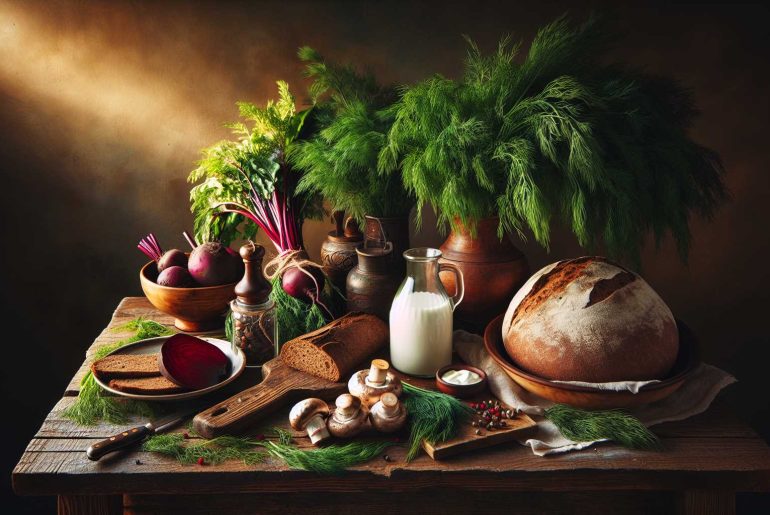
Diving into Polish cuisine, we find essential ingredients like potatoes, flour, dairy, cabbage, and wild mushrooms that are central to its delicious dishes. These ingredients reflect Poland’s farming history and are crucial for making the comforting and hearty meals associated with Polish food.
Each ingredient plays a special role, and together, they create something truly special. As we look closer, we learn not just about the food, but also the stories and traditions behind them.
Let’s explore these key ingredients and see how they’re used in Polish cooking, offering a tasty journey through history.
The Role of Potatoes
Potatoes play a crucial role in Polish cuisine, serving as a key ingredient in many traditional dishes. First brought to Poland in the late 16th century, potatoes have become a fundamental part of the country’s food culture. They are celebrated for their versatility, easily incorporated into various recipes due to their ability to be boiled, mashed, or fried. This adaptability makes them perfect for popular Polish dishes like ‘placki ziemniaczane’ (potato pancakes) and ‘zupa ziemniaczana’ (potato soup). Each recipe highlights the potato’s simple yet rich flavor, turning basic ingredients into delightful meals.
Polish cooks excel at using potatoes to enhance their dishes, showcasing the tuber’s unique qualities. This focus on potatoes not only underscores the importance of this ingredient in Polish cooking but also reflects a broader appreciation for sustainable and locally-sourced food. This approach to cooking demonstrates a deep connection to the land and its produce, emphasizing the value of using what is readily available to create nourishing and satisfying meals.
Flour Power in Polish Cuisine
Flour is as essential to Polish cooking as potatoes. It’s a key ingredient in numerous beloved dishes, from the everyday bread that’s a staple in every home to the more elaborate desserts that Poland is famous for, like paczki and chrusty. Flour isn’t just one type; it varies from wheat to rye, each bringing its distinct texture and taste to the dish. Understanding and using flour correctly is crucial in Polish cuisine. It’s about knowing which type to use and how it can elevate a simple recipe into something that’s an integral part of Poland’s culinary identity.
For example, consider the process of making traditional Polish bread. It’s not just about mixing flour and water. The type of flour used can affect everything from the bread’s crust to its crumb. Wheat flour, with its high gluten content, is perfect for creating loaves with a chewy texture and a hearty crumb. On the other hand, rye flour, which is lower in gluten, produces denser, more flavorful bread. This attention to detail and understanding of ingredients exemplifies the depth of knowledge required to master Polish baking.
When it comes to desserts, flour’s role is equally important. Take paczki, the rich, filled doughnuts that are a pre-Lenten tradition in Poland. The dough’s texture is key to a good paczek, and that texture comes from the flour. A high-protein wheat flour is typically used to give the doughnuts their soft yet chewy texture. Similarly, for chrusty, a type of fried pastry, the flour must be able to produce a dough that’s thin enough to crisp up beautifully when fried, yet strong enough not to fall apart.
Understanding flour in Polish cooking goes beyond knowing different types. It’s about recognizing how flour can transform simple ingredients into dishes that carry the essence of Polish tradition. It’s this transformation that places flour at the heart of Polish culinary heritage, making it a subject worth exploring for anyone interested in the rich tapestry of Poland’s food culture.
Dairy Essentials: Sour Cream and Cheese
Poland is well-known for its dairy products, especially sour cream and cheese, which play a crucial role in its cuisine. Sour cream, with its creamy texture and tangy taste, is a key ingredient in many Polish dishes. It enhances the flavor of soups, sauces, and even desserts. This versatility makes it a staple in the Polish kitchen.
On the other hand, Polish cheese offers a wide range of flavors and textures, from the soft and creamy twaróg (quark cheese) to the unique, smoked oscypek. Each type of cheese reflects the local traditions and the natural environment where it’s produced, adding a special touch to various dishes.
For example, twaróg is often used in cheesecakes and pierogi, showcasing its ability to complement both sweet and savory recipes. Oscypek, with its distinctive smoky flavor, is typically enjoyed with cranberry sauce, highlighting how contrasting flavors can create a delicious harmony. These cheeses not only add depth to dishes but also tell the story of Poland’s culinary heritage.
Incorporating sour cream and cheese into cooking transforms simple ingredients into satisfying meals that are both comforting and flavorful. Whether it’s a bowl of soup enriched with sour cream or a dish seasoned with the rich taste of Polish cheese, these dairy products are essential for bringing Polish culinary traditions to life. Through their use, meals become an experience that celebrates the country’s rich culture and the joy of eating.
The Importance of Cabbage
Cabbage is a key ingredient in Polish cuisine, known for its versatility and nutritional value. In Poland, it’s at the center of many traditional dishes, such as sauerkraut with its unique sour taste and gołąbki, which are cabbage rolls filled with meat and rice. You can find cabbage in various forms in Polish meals, including fermented, stewed, or fresh. This adaptability makes it a staple in the Polish diet.
Beyond its culinary uses, cabbage offers numerous health benefits. It’s a great source of vitamin C and helps with digestion. Its resilience in cold weather ensures its availability year-round in Poland, making it a reliable food source during the winter months.
When preparing Polish meals, cabbage is often a go-to ingredient for adding both flavor and nutrition. For example, making your own sauerkraut at home could be a simple and rewarding way to incorporate cabbage into your diet. All you need is cabbage, salt, and some time for fermentation. This not only allows you to enjoy the health benefits of cabbage but also gives you a taste of Polish culinary tradition.
Wild Mushrooms: A Forest Delight
In Poland, wild mushrooms are a significant part of the culinary scene, especially in autumn when they start appearing in the forests. These mushrooms are not just food; they’re a key ingredient that adds depth and flavor to various dishes. There are many types, such as the hearty bolete and the subtle chanterelle, each offering a distinct taste and texture that enhances meals in unique ways. People go out to collect these mushrooms, a practice that’s more than just gathering food; it’s a cultural tradition that connects Polish people to their environment.
When it comes to cooking, these wild mushrooms play a central role. They are often used in traditional recipes to create rich soups, stews, and sauces. The unique earthy flavors they bring can turn ordinary dishes into memorable culinary experiences. It’s the combination of these flavors that makes Polish cuisine stand out.
The tradition of mushroom picking is not only about finding ingredients for cooking. It’s an activity that families and friends enjoy together, passed down through generations. It symbolizes the strong bond between the people and the natural world around them. This tradition is so ingrained in Polish culture that it’s almost a rite of passage.
For those interested in exploring Polish cuisine, trying a dish with wild mushrooms is a must. Whether it’s a simple soup or a complex stew, the flavors of these mushrooms will provide a genuine taste of Poland’s culinary heritage. While foraging for mushrooms might not be possible for everyone, many Polish shops and markets offer wild mushrooms, allowing people to experiment with these flavors in their cooking.
Conclusion
So, let’s talk about what makes Polish food so special. It’s all about simple yet essential ingredients: potatoes, flour, dairy, cabbage, and wild mushrooms.
These aren’t just random picks; they’re the backbone of many Polish dishes. It’s like these ingredients capture the essence of Poland’s food culture.
When you see how much care goes into preparing these foods, you start to understand how important they are. It’s not just about eating; it’s about keeping a tradition alive and sharing something uniquely Polish.
So, when you dive into a Polish meal, you’re not just filling your stomach; you’re getting a taste of Poland’s heart and history.







Comments are closed.